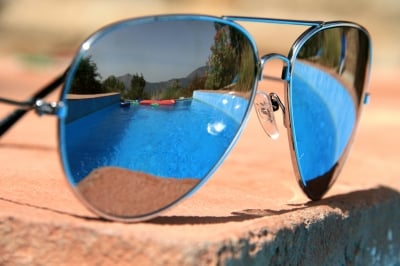As the summer season comes to a close, many of us rotate our wardrobes to prepare for fall and winter. Sunglasses, however, are a year-round necessity that should never come and go with the seasons. Many don’t realize that the risk of UV exposure remains steady all year long. As we’ve previously shared, overexposure to sunlight could lead to the development of a number of issues that can damage the eyes and the skin around them, ranging from different types of skin cancer on the eyelids to cataracts, macular degeneration, and photokeratitis. But far too often, patients look at sunglasses as an accessory rather than a necessity. Too often, they do not wear them year-round, and they do not purchase sunglasses that provide the proper protection.
Follow the lead of Myrtle Beach, S.C., ophthalmologist Gail Royal. Here’s what Royal tells her patients to look for when purchasing a proper pair of sunglasses that will guard their eyes from the sun’s UV rays.
– Complete UVA and UVB protection: Sunglasses should have lenses that block out 99 to 100 percent of UVA and UVB rays; lenses that meet the ANSI Z80.3 blocking requirements (standards set by the American National Standards Institute); and/or those that offer UV 400 protection.
– Hue: Lense coatings that block UV rays are clear, which means lenses with darker hues aren’t always more effective. Make sure patients are aware that certain hues can cause color perception issues. Gray, green, and brown lenses are a better choice than yellow and rose tints, which can create color distortion, according to WebMD.
– Polarization: Patients that spend a good bit of time on the water or driving can benefit from polarized lenses. As the Skin Cancer Foundation shares, these lenses help decrease glare from sunlight reflecting off of water and other similar surfaces.
– Photochromic Lenses: Patients that wear glasses can consider photochromic lenses, which automatically darken when exposed to UV rays, so they do not have to purchase a separate pair of prescription sunglasses (VSP).
– Size: Bigger is better! Suggest wrap-around style shades or those with large lenses so that patients’ eyes are guarded from more angles for broader protection.
– Fit: The Skin Cancer Foundation says sunglasses that fit properly are those that do not slip down one’s nose and are not heavy. WebMD recommends a close, snug fit that doesn’t pinch or rub.
How do you discuss the topic of sunglasses with your patients? Do you help them understand what qualities they should look for in a pair of shades and make recommendations? Share with us in a comment below!
Source: Darren Robertson via Freedigitalphotos.net
